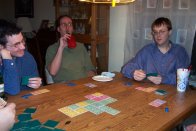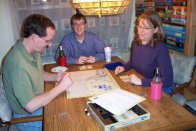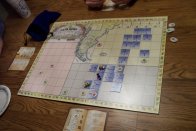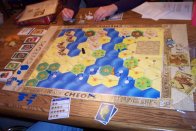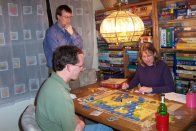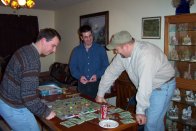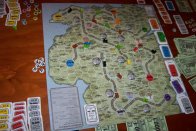
Games: M, Cape Horn, Stephensons Rocket, Settlers of Catan: Cheops Historical Scenario
Attendees: Doug, Ed, Jon, Mark, Robert and Susan
Reporter: Susan Rozmiarek
M: Doug, Ed, Jon, Mark, Robert, Susan
We decided to stick together and play a six player game first. Ed suggested this as a light filler to start us off. Light?!?! Ha! Apparently not for us. Players had to be threatened numerous times with the dreaded G8 game timer as they pondered their moves. The play is very simple. All you do is lay a tile down on your turn. Tiles have three characteristics: a number, a color and a symbol. They must be placed orthogonally adjacent to at least one other tile that shares at least one of its characteristic. If placed next to more than one tile, all tiles it touches must share a characteristic with it. When the 5th or 6th tile is placed in a row or column and it matches two characteristics with a tile, that row is scored. Each player, in counterclockwise order, must pick up a tile if he can. Tiles must be picked up so that all tiles remaining are touching at least one other tile. Players keep the tiles in front of them and try to collect sets of the same color. At the end of the game, you add up the face values of two of your sets and subtract the face values of all tiles of any other colors that you collect. In addition, players start the game with six blue chips. Each time they place a tile touching more than one other tile, they get to steal (tiles touching) - 1 chips from the player to their right. These chips are worth 10 points each at the end of the game.
Ed and I were so hosed in this game. Robert and Mark kept being able to trigger scoring rounds. Ed and I were at the end of the chain and either got no tiles or bad tiles. Jon suffered, too, when Mark triggered a scoring round. We did realize early in the game that we had been playing incorrectly in that we were choosing tiles in a clockwise order when scoring a row instead of counterclockwise. We went ahead and finished the game the incorrect way we had started it. Of course, those of us who ended up at the bottom then declared the results "null and void" because of this error ;-)
I enjoy this game more every time I play it (even with the wrong rules). I chuckle at its lack of theme. It seems someone was too lazy to come up with one to paste on like most German games have.
Time w/ rules explanation: 70 min.
Results: Doug 270, Mark 260, Robert 160, Jon 150, Susan 150, Ed 120
We now split into two groups of three. Ed, Robert and Jon went off to play Stephensons Rocket while Mark, Doug and I tried our hands at racing clippers around the turbulent waters of Cape Horn.
Cape Horn: Doug, Mark, Susan
None of us had ever played this eBay acquisition of mine before, so we first had to slog through the rules. The victory conditions were worded differently in different places so this caused us some confusion at first. We finally figured it out and off sailing we went.
Cape Horn is a race game in which you are trying to sail your clipper ship around surprisingly, Cape Horn. The board is divided into three zones. In each zone there are three different nautical stations in one of three colors. The winner is the person who stops on a nautical station in each of the three zones but of different colors OR two zones plus cross the finish line. Movement is via tiles that indicate the directions and number of spaces your ship can move. On his turn, a player may place as many of these wind tiles as he wants (up to the number he has in his hand), the rule being that each tile must be placed vertically, horizontally, or diagonally adjacent to another tile on the board. Then he moves his clipper, based on the directions on the tile on which it currently sits. It must go the full number of spaces indicated and must end up on another tile. Ships cannot occupy the same tile unless it is a nautical station. In addition, on your turn, you get one "sail point." These can be cashed in for things like taking an extra turn, placing a tile over another tile, moving a direction not indicated on the tile, and buying extra tiles to add to your hand.
It was immediate obvious that hosing your competition by laying bad tiles in front of them is key in this game. Doug shot off to an early lead, with me trying to follow in his wake, and Mark close behind. Unfortunately, it was a very quick race. We had not studied the different direction and movement combinations on the tiles beforehand and so did not realize some of the possibilities. Doug was able to place a diagonal three tile on the green nautical station in zone two and moved on to it. He then paid 5 sail pints to move again and laid three diagonal tiles to reach the red station in zone three to claim his third stop and the victory. Now that we're familiar with the game, Mark and I certainly won't let him get away with that again! All in all, I think the game has potential for a nice, light, tactical filler once we get more familiar with it.
Time w/ rules explanation: 45 min.
Results: Doug, Susan/ Mark
Stephensons Rocket was still going full force, so we scanned the shelves and settled on Settlers of Catan: Cheops Historical Scenario.
Settlers of Catan: Cheops Historical Scenario: Doug, Mark, Susan
This was new to us but fortunately, all three of us had played Settlers of Canaan once, to which this bears striking similarities. Therefore, we were able to go over the rules fairly quickly and dive right in. The Cheops scenario is set in ancient Egypt. It is much like regular Settlers with a few interesting twists. The game ends when someone gets to 12 victory points but it also has another endgame condition. During the course of the game players will be adding bricks to a pyramid. In addition, a neutral brick is added every time the robber is rolled. The game will also end if and when the pyramid is completed. Players have to have a settlement adjacent to the building site to add bricks at resource cost of an ore and a brick. The person who contributes the most bricks to this wonder gets the +3 Pharaoh's Blessing card. The person(s) who contribute the least or not at all get a -2 Pharaoh's Curse card. The Longest Road card is not used. We weren't sure about the Largest Army so we played without it. Another interesting twist was the concept of trade routes. While the rules for building mostly remained the same, if you could connect to others' roads and ships in such a way that you could trace a route to a port, then you could pay the owner of the port one gold to use it. You could also use a player's settlement at the pyramid's building site in this manner. There are two hexes on the map that produce gold, which acts like a normal commodity, except it doesn't count toward your hand limit when the robber is rolled.
The biggest challenge for us was right at the start when we placed our settlements. (You get to place three and all must border the Nile River.) We all stared in bewilderment at the very odd board. Except for one hex with a lousy 4 on an island, all the wood was located in one corner along with a wood port. The ore was concentrated in one place, and the bricks were also isolated. What there were in abundance were wheat and sheep hexes bordering the river. Mark, placing first, without hesitation plunked his settlement on the prime wood spot in the corner. Both Doug and I settled for the island wood hex, with me taking the brick port. We all got spots on brick hexes, with Doug and Mark just about clinching the gold hexes. We each placed our last settlements on the stretch of wheat and sheep hexes along the river. As the game got going there was first a race to be able to get a settlement to the pyramid building site before being blocked by someone else. Fortunately, we were all able to get our own spots and peace prevailed for the moment. Mark, due to his initial placement was the lumber king in the early part of the game. Doug and I were practically in tears as we watched Mark trade away all that precious wood via his wood port. Always having an abundance of wheat in my hand, I decided to build towards the wheat port. Doug, also wheat-rich, built in to my trade route so he could use my ports. After that Mark's wood was not as important. The next race was across the desert towards the range of mountains to get ore to build cities and bricks for the pyramid. Now a hilarious thing happened. Just as Mark reached the ideal ore spot ahead of Doug and me and was ready to build his settlement, he realized he didn't have one left. Neither did Doug. They would have to build a city to get one back but they didn't have ore. A tight spot to be sure. I realized that I'd be better off building at the wheat port and trading wheat for ore so that's what I did first. Doug was able to take advantage of my port, but Mark was too far away. The last part of the game was a race between Mark and me to build the pyramid and gain the Pharaoh's Blessing. As I pulled ahead it was a fight between Doug and Mark to not be the one with the fewest bricks. Meanwhile, everyone was also trying to build cities. At one point Mark held the Blessing card and had 11 victory points. The game ended with me finishing the pyramid and holding the Pharaoh's Blessing card for the win.
Time: 90 min.
Scores: Susan 12, Doug 9, Mark 8
I'm finding that I enjoy the variety of the different Settler's historical scenarios better than the regular game. In this one, you never had the resources you needed and often nobody else had them or would trade them. The ports were thus really important and there were also many painful 4:1 trades.
Stephensons Rocket: Ed, Jon, Robert
Time: 90 min.
Scores: Jon 98, Ed 90, Robert
This page viewed
E-mail Ed Rozmiarek with questions or problems concerning this page.
Copyright © 2003, Ed Rozmiarek
